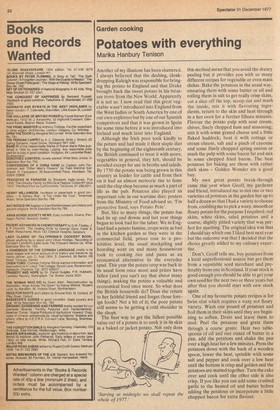Garden cooking
Potatoes with everything
Marika Hanbury Tenison
Another of my illusions has been shattered. I always believed that the dashing, cloakdropping Raleigh was responsible for bringing the potato to England and that Drake brought back the sweet potato in his treasure trove from the New World. Apparently it is not so. I now read that this great vegetable wasn't introduced into England from the West Indies or South America by one of our own explorers but by one of our Spanish competitors and that it was grown in Spain for some time before it was introduced into Ireland and much later into England.
Although the Irish poor took kindly to the potato and had made it their staple diet by the beginning of the eighteenth century, the British continued to treat it with scorn; vegetables in general, they felt, should be avoided except for use in broths and salads. By 1750 the potato was being grown in this country as fodder for cattle and from then on it had an almost meteoric rise to fame until the chip shop became as much a part of life as the pub. Potatoes also played an important role in our wartime diet: posters from the Ministry of Food advised us, 'I'm protective food, says Potato Pete'.
But, like so many things, the potato has had its up and downs and last year things began to look bad for the tuber. We in England had a potato famine, crops were as bad in the kitchen garden as they were in the commercial field, prices rose to a prohibitive level, the usual stockpiling and hoarding went on and many housewives took to cooking rice and pasta as an economical alternative to the everyday spud. This year the potato crop was back to its usual form once more and prices have fallen (and you can't say that about many things), making the potato a valcuable and economical food once more. So what does the British housewife do? Does she return to her faithful friend and forget those foreign foods? Not a bit of it; the poor potato still seems to be getting a cold shoulder in the shops. The best way to get the fullest possible value out of a potato is to cook it in its skin as a baked or jacket potato. Not only does this method mean that you avoid the dreary peeling but it provides you with so many different recipes for vegetable or even main dishes. Bake the potatoes in the usual way, smearing them with some butter or oil and rolling them in salt to get really crisp skins, cut a slice off the top, scoop out and mash the inside, mix it with flavouring ingredients, return to the skin and heat through in a hot oven for a further fifteen minutes. Flavour the potato pulp with sour cream, chives, finely chopped ham and seasoning; mix it with some grated cheese and a little flaked haddock; beat it with cottage or cream cheese, salt and a pinch of cayenne and some finely chopped spring onions or mash the pulp with some bacon fat and mix in some chopped fried bacon. The best potatoes for baking are those with rather dark skins — Golden Wonder are a good buy.
My own great potato break-through came this year when Geoff, my gardener and friend, introduced me to not one or two varieties of potatoes in the garden but up to half a dozen so that I had a variety to choose from, enabling me to pick a waxy, smooth or floury potato for the purpose I required; red skins, white skins, salad potatoes and a coarse, slightly pitted variety that was perfect for mashing. The original idea was that I should say which one I liked best next year but the outcome was that I decided that the choice greatly added to my culinary expertise.
Don't, Geoff tells me, buy potatoes from a local unprofessional source but get them from a reputable seed merchant and preferably from one in Scotland. If your stock is good enough you should be able to get your own seed for the next two or three years but after that you should start with new stock again.
One of my favourite potato recipes is for Swiss rosti which requires a waxy not floury variety. Wash one pound of potatoes and boil them in their skins until they are beginning to soften. Drain and leave them to cool. Peel the potatoes and grate them through a coarse grater. Heat two tablespoons of oil and one ounce of butter in a pan, add the potatoes and shake the pan over a high heat for a few minutes. Press the potatoes down with the back of a wooden spoon, lower the heat, sprinkle with some salt and pepper and cook over a low heat until the bottom is crisp and golden and the potatoes are matted together. Turn the cake over and cook until the other side is also crisp. If you like you can add some crushed garlic to the heated oil and butter before adding the potatoes or incorporate a little chopped bacon for extra flavour.






































 Previous page
Previous page